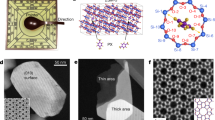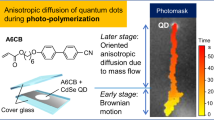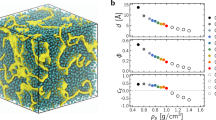Abstract
Periodic mesoporous materials formed through the cooperative self-assembly of surfactants and framework building blocks can assume a variety of structures1,2,3, and their widely tuneable properties make them attractive hosts for numerous applications4,5,6,7. Because the molecular movement in the pore system is the most important and defining characteristic of porous materials8, it is of interest to learn about this behaviour as a function of local structure. Generally, individual fluorescent dye molecules can be used as molecular beacons with which to explore the structure of—and the dynamics within—these porous hosts9,10,11,12,13, and single-molecule fluorescence techniques provide detailed insights into the dynamics of various processes, ranging from biology14,15 to heterogeneous catalysis16. However, optical microscopy methods cannot directly image the mesoporous structure of the host system accommodating the diffusing molecules, whereas transmission electron microscopy provides detailed images of the porous structure17, but no dynamic information. It has therefore not been possible to ‘see’ how molecules diffuse in a real nanoscale pore structure. Here we present a combination of electron microscopic mapping and optical single-molecule tracking experiments to reveal how a single luminescent dye molecule travels through linear or strongly curved sections of a mesoporous channel system. In our approach we directly correlate porous structures detected by transmission electron microscopy with the diffusion dynamics of single molecules detected by optical microscopy. This opens up new ways of understanding the interactions of host and guest.
This is a preview of subscription content, access via your institution
Access options
Subscribe to this journal
Receive 51 print issues and online access
$199.00 per year
only $3.90 per issue
Buy this article
- Purchase on Springer Link
- Instant access to full article PDF
Prices may be subject to local taxes which are calculated during checkout




Similar content being viewed by others
References
Beck, J. S. et al. A new family of mesoporous molecular sieves prepared with liquid-crystal templates. J. Am. Chem. Soc. 114, 10834–10843 (1992)
Sen, T., Tiddy, G. J. T., Casci, J. L. & Anderson, M. W. Synthesis and characterization of hierarchically ordered porous silica materials. Chem. Mater. 16, 2044–2054 (2004)
Zhao, D. et al. Triblock copolymer syntheses of mesoporous silica with periodic 50 to 300 angstrom pores. Science 279, 548–552 (1998)
Dag, Ö., Ozin, G. A., Yang, H., Reber, C. & Bussière, G. Photoluminescent silicon clusters in oriented hexagonal mesoporous silica film. Adv. Mater. 11, 474–480 (1999)
Davis, M. E. Ordered porous materials for emerging applications. Nature 417, 813–821 (2002)
Shen, J. L. et al. Photoluminescence sites on MCM-48. Micropor. Mesopor. Mater. 64, 135–143 (2003)
Yang, C.-M., Cho, A.-T., Pan, F.-M., Tsai, T.-G. & Chao, K.-J. Spin-on mesoporous silica films with ultralow dielectric constants, ordered pore structures, and hydrophobic surfaces. Adv. Mater. 13, 1099–1102 (2001)
Kukla, V. et al. NMR studies of single-file diffusion in unidimensional channel zeolites. Science 272, 702–704 (1996)
Hellriegel, C., Kirstein, J. & Bräuchle, C. Tracking of single molecules as a powerful method to characterize diffusivity of organic species in mesoporous materials. New J. Phys. 7, 23 (2005)
Jung, C., Hellriegel, C., Michaelis, J. & Bräuchle, C. Single-molecule traffic in mesoporous materials: translational, orientational, and spectral dynamics. Adv. Mater. 19, 956–960 (2007)
Kirstein, J. et al. Exploration of nanostructured channel systems with single-molecule probes. Nature Mater. 6, 303–310 (2007)
McCain, K. S., Hanley, D. C. & Harris, J. M. Single-molecule fluorescence trajectories for investigating molecular transport in thin silica sol-gel films. Anal. Chem. 75, 4351–4359 (2003)
Werley, C. A. & Moerner, W. E. Single-molecule nanoprobes explore defects in spin-grown crystals. J. Phys. Chem. B 110, 18939–18944 (2006)
Schmidt, T., Schütz, G. J., Baumgartner, W., Gruber, H. J. & Schindler, H. Imaging of single molecule diffusion. Proc. Natl Acad. Sci. USA 93, 2926–2929 (1996)
Seisenberger, G. et al. Real-time single-molecule imaging of the infection pathway of an adeno-associated virus. Science 294, 1929–1932 (2001)
Roeffaers, M. B. J. et al. Spatially resolved observation of crystal-face-dependent catalysis by single turnover counting. Nature 439, 572–575 (2006)
Sakamoto, Y. et al. Direct imaging of the pores and cages of three-dimensional mesoporous materials. Nature 408, 449–453 (2000)
Holtrup, F. O. et al. Terrylenimides: new NIR fluorescent dyes. Chem. Eur. J. 3, 219–225 (1997)
Jung, C. et al. A new photostable terrylene diimide dye for applications in single molecule studies and membrane labeling. J. Am. Chem. Soc. 128, 5283–5291 (2006)
Brinker, C. J., Lu, Y., Sellinger, A. & Fan, H. Evaporation-induced self-assembly: nanostructures made easy. Adv. Mater. 11, 579–585 (1999)
Saxton, M. J. & Jacobson, K. Single-particle tracking: applications to membrane dynamics. Annu. Rev. Biophys. Biomol. Struct. 26, 373–399 (1997)
Acknowledgements
We thank K. Müllen for providing the TDI dye; Siltronic AG for the silicon wafers; the group of P. Müller-Buschbaum for the 2D-GISAXS measurements; and S. Schmidt and B. Platschek for assistance with electron microscopy. This work was funded by two Collaborative Research Centres (‘Manipulation of matter at the nanometer length scale’ and ‘Dynamics and intermediates of molecular transformations’) of the German Research Foundation (DFG) and by the Nanosystems Initiative Munich (NIM), as well as the Center for Integrated Protein Science Munich (CiPSM).
Author information
Authors and Affiliations
Corresponding authors
Supplementary information
Supplementary Information
This file contains Supplementary Figures 1-2 with Legends, Supplementary Table 1 and Legends for Supplementary Movies 1-3. (PDF 2427 kb)
Supplementary Movie 1
This file contains Supplementary Movie 1 which is a wide-field movie of fluorescent dye molecules diffusing through the porous system. Temporal resolution: 200 ms per frame. Animation with 5x real time. (MOV 6699 kb)
Supplementary Movie 2
This file contains Supplementary Movie 2 which shows the animation of the single particle trajectory superimposed with the porous structure from TEM (see Fig. 4a). The molecule clearly diffuses along the porous structure. Animation with 2x real time. (MOV 2655 kb)
Supplementary Movie 3
This file contains Supplementary Movie 3 which shows the animation of the single particle trajectory superimposed with the porous structure from TEM (see Fig. 4c). The molecule clearly diffuses along the porous structure and bounces back at domain boundaries. Animation with 2x real time. (MOV 4607 kb)
Rights and permissions
About this article
Cite this article
Zürner, A., Kirstein, J., Döblinger, M. et al. Visualizing single-molecule diffusion in mesoporous materials. Nature 450, 705–708 (2007). https://doi.org/10.1038/nature06398
Received:
Accepted:
Published:
Issue Date:
DOI: https://doi.org/10.1038/nature06398
This article is cited by
-
Single organic molecules for photonic quantum technologies
Nature Materials (2021)
-
Pulsed field gradient NMR diffusion measurement in nanoporous materials
Adsorption (2021)
-
Single-molecule observation of diffusion and catalysis in nanoporous solids
Adsorption (2021)
-
Deciphering nanoconfinement effects on molecular orientation and reaction intermediate by single molecule imaging
Nature Communications (2019)
-
In situ quantitative single-molecule study of dynamic catalytic processes in nanoconfinement
Nature Catalysis (2018)
Comments
By submitting a comment you agree to abide by our Terms and Community Guidelines. If you find something abusive or that does not comply with our terms or guidelines please flag it as inappropriate.



